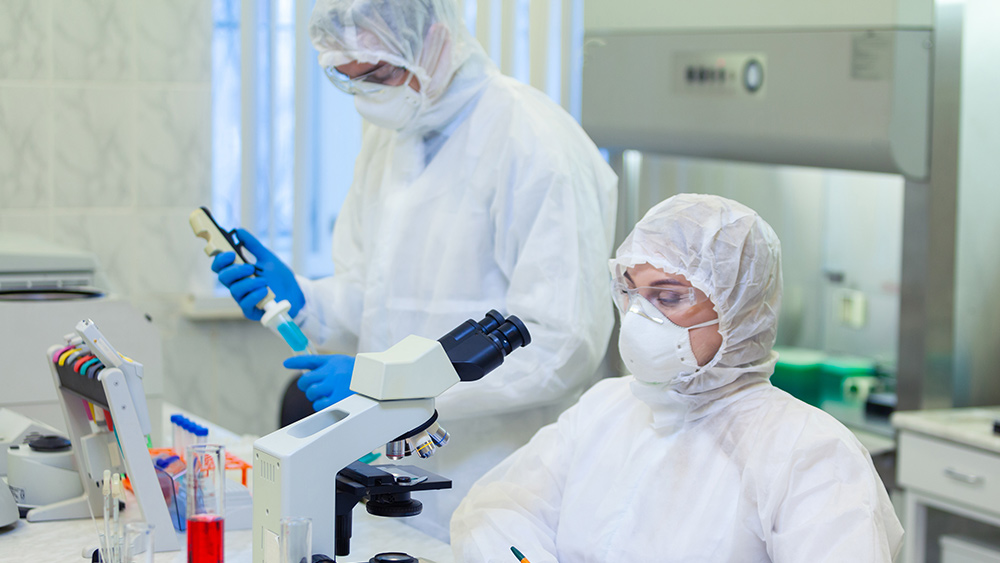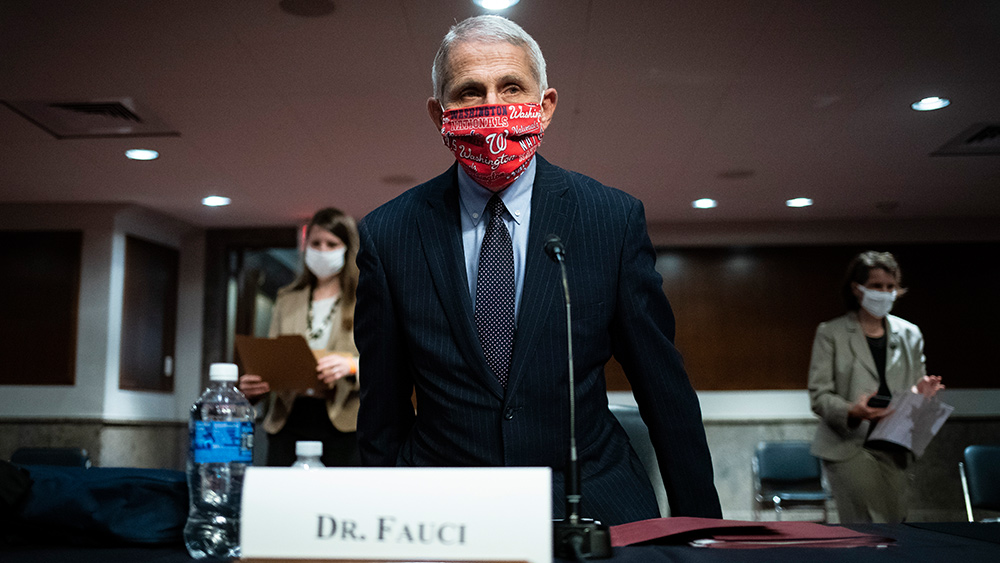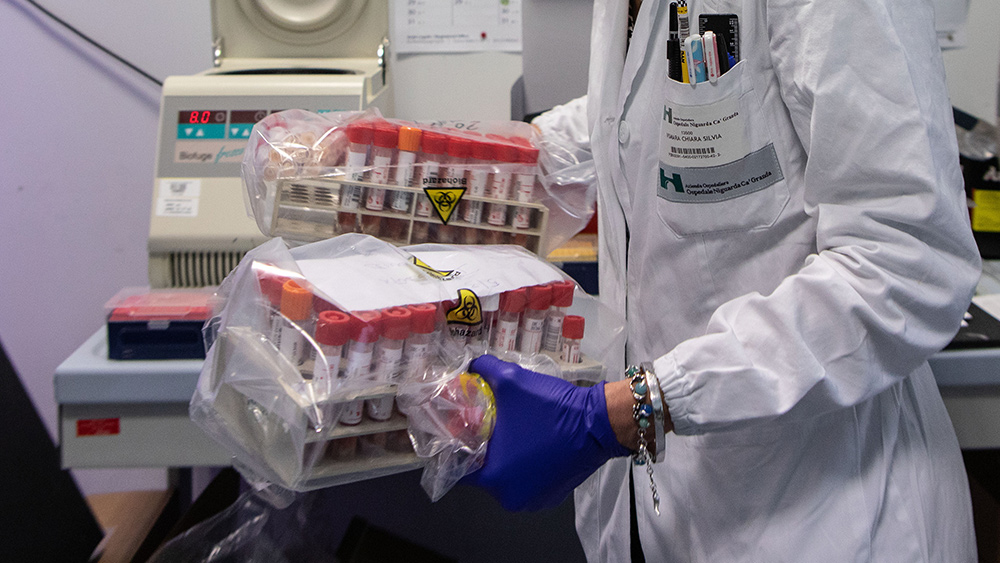How NIH-funded research in China could have led to the COVID-19 pandemic
09/23/2021 / By News Editors

A multimillion-dollar bat coronavirus research grant, funded by the National Institutes of Health (NIH), was made public last week, revealing that researchers based in Wuhan, China had manipulated coronaviruses in ways that led to increased severity of infection, employing platforms that tested the ability of bat coronaviruses to use human receptors.
(Article by Shannon Murray republished from USRTK.org)
The grant documents underscore the perils of the collection of and experimentation on potentially pathogenic viruses, and shed new light on U.S.-funded coronavirus experiments in Wuhan, China for five years prior to the COVID-19 pandemic.
The new information disclosed in the grant proposal and its interim reports do not establish that the research led to the pandemic. But they do suggest that it was possible.
The NIH-funded, five-year grant was awarded in 2014 to the U.S.-based EcoHealth Alliance, with EcoHealth President Peter Daszak as “principal investigator” in collaboration with several researchers in China, including two working at China’s Wuhan Institute of Virology (WIV).
A key collaborator on the grant was Ralph Baric, of the University of North Carolina, providing expertise in mouse models for coronavirus infections. The grant was renewed in 2019 but then cancelled in 2020 as the pandemic set off panic around the globe.
A copy of the research plan and interim reports, titled “Understanding the Risk of Bat Coronavirus Emergence,” was obtained through litigation against the NIH and publicly released by The Intercept.
The documents show that the NIH grant was for $3.1 million, of which $599,000 went to the WIV and to researcher Zhengli Shi, who specialized in the study of severe acute respiratory syndrome coronavirus-1 (SARS-CoV-1) and similar viruses, called SARS related (SARSr)-CoVs.
Many scientists have posited a possible lab origin of SARS-CoV-2, and suggested the WIV as a possible source for the origin of the novel coronavirus SARS-CoV-2, which causes COVID-19.
Coronaviruses (CoVs) emerging from wildlife are a “significant threat to global health,” the grant claims, with bats considered a “natural reservoir of these viruses.”
With that in mind, the authors said that the purpose of their research was to “examine the risk of future coronavirus … emergence from wildlife” using a range of research techniques and to understand “what factors increase the risk of the next CoV emerging in people …”
The work involved screening more than 30 species of bats for CoVs and then developing strategies for assessing the potential spillover of coronaviruses from bats to humans, according to the grant documents.
But it is possible that, in seeking to learn how to avoid spillover events, the work actually caused one.
How it could have happened
How might the EcoHealth Alliance grant have caused, or contributed to, the pandemic? Here are some possible scenarios based on a close reading of the grant.
- During fieldwork, collection, and containment of bat SARSr-CoV samples, people could have been accidentally infected. The research involved collecting samples from bats in four Chinese provinces: Yunnan, Guangdong, Guangxi and Fujian.
The researchers explained their prolific sampling of Chinese bats and identification of new coronaviruses: “We have identified sequences from 268 novel bat-CoVs (140 from China alone),” they wrote in the grant. “We have an additional 5000+ clinical samples from free-ranging bats and rodents from Guangdong province.”
The grantees acknowledged that their work had serious implications, writing in the grant documents that “some SARSr-CoVs currently circulating in bats in southern China are likely able to infect and replicate within people.” [Emphasis in original].
In fact, the most closely related virus to SARS-CoV-2 identified to date was found by WIV scientists in a mineshaft in Mojiang (Yunnan Province). In 2012-2013, six miners experienced acute respiratory distress syndrome after exposure to bat feces in this mineshaft, and three died.
- There is evidence of lax bat-handling practices and minimal use of personal protective equipment at WIV and Wuhan University, where parts of the research were conducted. By their own admission, the researchers noted, this work could be dangerous.
“Fieldwork involves the highest risk of exposure to SARSr-related or other bat CoVs, while working in caves with high bat density overhead and the potential for fecal dust to be inhaled,” according to the grant documents.
The grant documents state that “Tyvek suits and HEPA-filtered Powered Air Purifying and Supplied Air Respirator Systems (PAPRs) will additionally be worn in cave systems where there is a higher risk of contact with aerosolized bat feces.”
If any of those bat samples contained a close relative of SARS-CoV-2 infectious to humans, an accidental infection during the course of fieldwork, subsequent lab procedures or containment could have led to a transmissible SARS-CoV with greater similarity to SARS-CoV-2 than the currently reported strains.
In fact, analysis of some early strains of SARS-CoV-2 shows that they may be more similar to bat coronaviruses than previously thought, based on evidence recovered from viral sequences deleted from NIH sequence archives.
- During lab experimentation with the bat coronaviruses, it is possible that a novel virus was produced with greater similarity to SARS-CoV-2 than those reported in the NIH grant. The researchers stated in the grant that they developed an in vivo model, that is, mice genetically engineered to carry human angiotensin-converting enzyme 2 (hACE-2), the receptor for SARS-CoV-1 and SARS-CoV-2. The research group also reported that they were successful in generating new SARS-like coronaviruses. They did this by splicing the RNA sequences of the novel spike proteins they discovered into the viral ‘backbone’ of known lab strains. This kind of novel virus is called a chimera because it consists of genetic elements from different viruses.
In this way, the researchers created three chimeric viruses, each with a different spike protein, from bats.
- Though the grant does not mention a virus similar enough to SARS-CoV-2 to be a direct progenitor, it is possible that other chimeric viruses were tested in this model, but were not reported in the grant. The researchers had access to troves of novel coronaviruses collected during fieldwork, including unreported bat viruses. It is common for researchers to present some but not all data in interim grant reports. The research described in the grant established a platform that could have easily been used to study other chimeric viruses more closely related to SARS-CoV-2 than those mentioned in the grant.
There are indications of this within the grant documents. While results from infection of hACE-2 mice with three chimeric viruses were presented, the researchers wrote in the grant, “[w]e cannot anticipate exactly how many viruses we will find that are candidates for experimental models…and that we will identify approximately 20 viruses that will be used for mouse infection experiments.” It is possible that the researchers generated a novel chimeric virus with more similarity to SARS-CoV-2 than those reported.
Experiments on human ACE-2 mice
The NIH grant describes important research on mice with human ACE-2 receptors.
The researchers infected the hACE-2 mice with the chimeric SARS-like bat coronaviruses to see how sick they would get, and whether they would shed infectious virus compared to the original viral strain. They found that hACE-2 mice infected with some of the chimeric viruses lost more body weight and shed more virus in the lungs than those infected by the original viral strain at certain time points. This research resulted in chimeric viruses that gained infectious and pathogenic properties.
“We’ll infect them [hACE-2 mice] with cultured bat coronaviruses and determine which organs become infected and whether these mice are capable of shedding infectious virus”, the grant proposed. The grant aimed to study tissues of the chimeric virus-infected hACE-2 mice for virus replication.
The grant proposed testing different transmission routes in which the mice could be infected, comparing nasal infection versus other routes. The grant outlines, “[W]e will perform in vivo infection experiments in humanized mice modified to carry human ACE2…gene in the Wuhan Institute of Virology BSL-3 animal facility…[t]his work will provide information about viral pathogenicity, tissue tropism, transmission route, and infection symptom.”
An outstanding question is whether the chimeric viruses can be transmitted between the hACE-2 mice. Whether the scientists explicitly reported on this is not the question, but rather, was a novel chimeric bat virus engineered that was also transmissible between hACE-2 mice? While the grant does not discuss repeated passage of viruses in hACE-2 mice, the platform also sets up biosafety concerns about this possibility.
A weakness in the prominent ‘proximal origin’ paper?
Some scientists who have argued against a lab origin for SARS-CoV-2 contend that the virus has a signature of it being adapted in an animal host with an intact immune system, for which no such appropriate laboratory model has been described.
One of these arguments against a lab origin of SARS-CoV-2, advanced by scientist Kristian Andersen and colleagues, and published as an influential correspondence in Nature Medicine, was “[s]ubsequent generation of a polybasic cleavage site would have then required repeated passage in cell culture or animals with ACE2 receptors similar to those of humans, but such work has also not previously been described.” [Emphasis ours.]
However, the grant shows this is not correct; the experimentation on the hACE-2 mice establish such a model.
Infection of hACE-2 mice with the novel chimeric bat coronaviruses could have supported new viruses with sequence changes that make them better able to infect human cells. These could be more similar in sequence to SARS-CoV-2 than the original chimeric virus infecting strains. The hACE-2 expressing mice could have enabled some human adaptation of the chimeric SARS-like bat coronaviruses in vivo, generating viruses with more similarity to SARS-CoV-2 than those reported to date. This is another possible explanation for how NIH-funded research in China could have led to the COVID-19 pandemic.
The bottom line
In addition to searching for spillover events, the research outlined in the grant had the potential to generate a spillover event. This could have occurred as an accidental infection during fieldwork and laboratory handling of bat SARSr-CoVs; during containment or storage of them; or during the laboratory engineering of novel chimeric bat coronaviruses; or, after these novel viruses were used to infect hACE-2 mice, leading to a more infectious, transmissible, and/or pathogenic virus that was a precursor to SARS-CoV-2. The possibility of a lab leak or lab-acquired infection with any of these novel coronaviruses during lab experimentation raises serious biosafety concerns.
Though the bat coronavirus grant project has concluded, it is entirely possible that other studies using this platform were performed or are now being performed, including those related to viral transmission. It is noteworthy that it took civil litigation to bring these grant documents to light, even though the research itself was paid for by U.S. taxpayers. It is also noteworthy that EcoHealth Alliance has received nearly $40 million in multiple grants from the Department of Defense, and DOD grant data is often considered classified and withheld from the public.
And though the 5-year bat coronavirus research grant was only renewed for one additional year, a $7.5 million NIH grant, titled “Understanding Risk of Zoonotic Virus Emergence in EID Hotspots of Southeast Asia,” was awarded to EHA in 2020 to expand on the platforms established in the 2014 grant.
This newer grant, with Daszak again as principal investigator, was also made public last week by the Intercept. The new grant is a consortium grant that adds more collaborators and lab sites where the research will be performed, including a BSL-4 facility in Boston. Funding is approved for the budget cycle of June 17, 2020 through May 31, 2025.
The bottom line is this: It is unclear whether the work performed under the 2014 bat coronavirus NIH grant played a role in the COVID-19 pandemic. But the EcoHealth Alliance and WIV collection and storage of SARS-related bat coronaviruses, and the creation and use of chimeric novel bat coronaviruses with human ACE-2 expressing mouse platforms, could have sparked the pandemic.
Congress should launch an investigation into U.S. government funding of this type of risky research as part of a full and thorough investigation of the origins of the pandemic.
U.S. Right to Know believes transparency in science is essential to protection of public health, including preventing future pandemics.
Read more at: USRTK.org and Conspiracy.news.
Tagged Under: big government, China, conspiracy, coronavirus, COVID, deception, infections, medical experiments, NIH, outbreak, pandemic, research, truth, WIV
RECENT NEWS & ARTICLES
MedicalExperiments.News is a fact-based public education website published by MedicalExperiments News Features, LLC.
All content copyright © 2019 by MedicalExperiments News Features, LLC.
Contact Us with Tips or Corrections
All trademarks, registered trademarks and servicemarks mentioned on this site are the property of their respective owners.




















